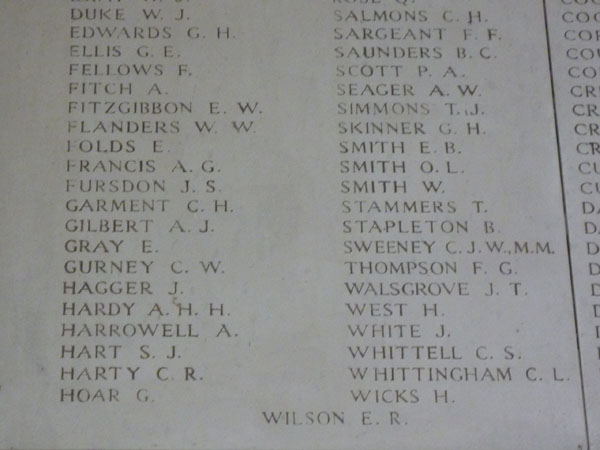H. C. Wickens
Service no. 238091
Driver, Royal Field Artillery, “C” Bty., 342nd Bde.
Born in Westminster; enlisted in Lambeth
Died on 22 October 1918, aged 29
CWGC: “Son of Mr and Mrs H. Wickens, of 28 Wyvil Road, London.”
Remembered at Brookwood Military Cemetery, near Pirbright, Woking, Surrey
After volunteering in 1914 and completing his training, Henry Charles Wickens served with ‘C’ battery. He became seriously ill (the details are unknown) and died in the military hospital at Millbank, London in 1918.
In 1911 Henry Charles Wickens, then aged 22, was an assistant in a fish shop. He lived with his parents, Alfred Wickens, 49, who worked for a jam maker and was born in Camberwell, and Harriett Wickens, 47, whose place of birth is unknown. Henry was one of three children (the other two lived elsewhere) and the family occupied three rooms at 123 Wandsworth Road.
In 1913 Henry married Clara Caroline (née Davison), a cap finisher, at St Anne’s, South Lambeth Road. Their child, Henry Charles, was born in 1916, when Henry, then working as a doorman, and Clara lived at 75 Hercules Road, Lambeth.
In 1920 Clara married Henry F. Glasgow and died in 1927, four months after the birth of their fourth child.
National Roll of the Great War 1914-1918
WICKENS, H.C., Driver, R.F.A.
After volunteering in 1914, and completing his training he served at various stations with his battery engaged on important duties. He was unsuccessful in obtaining his transfer overseas and falling seriously ill, died in hospital at Mill Bank in 1918.
“His memory is cherished with pride.”
27, Wyvil Road, Wandsworth Road, S.W.8.
Information from the censuses
In 1911 Henry Charles Wickens, 22, lived at 123 Wandsworth Road, Stockwell and earned his living as an assistant in a fish shop. He was born in Leicester Square. He lived with his parents, Alfred Wickens, 49, who worked for a jam maker, and was born in Camberwell, and Harriett Wickens, 47, whose birthplace was not known. Henry was one of three surviving children (two had died). The family shared three rooms. In 1901 they family lived at 116 York Road, Lambeth.

